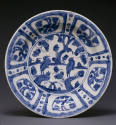Plate
Date17th century
MakerIranian (
Persian
)
Label TextWares such as this were previously knows as Kubachi ware, named for the town of Kubachi in northwestern Iran, but they were likely made in the nearby city of Tabriz. The design of this plate is modeled after the style of the late Ming Chinese blue-and-white export porcelain, the so-called Kraak ware that features panels radiating from a central medallion.
Object number48.146
Photo CreditPhoto: Paul Macapia
Exhibition HistorySeattle, Washington, Seattle Art Museum, "Porcelain Stories: From China to Europe", February 17, 2000-May 7, 2000 (2/17/2000 - 5/7/2000)
Seattle, Washington, Seattle Asian Art Museum, Boundless: Stories of Asian Art, Feb. 8, 2020 - ongoing.Published ReferencesFinlay, Robert. "The Pilgrim Art: Cultures of Porcelain in World History". Berkeley, Los Angeles and London: University of California Press, 2010, illustrated pl. 22
Emerson, Julie, Jennifer Chen, & Mimi Gardner Gates. "Porcelain Stories, From China to Europe." Seattle, WA: Seattle Art Museum, 2000, p. 99.
Foong, Ping, Xiaojin Wu, and Darielle Mason. "An Asian Art Museum Transformed." Orientations vol. 51, no. 3 (May/June 2020): p. 61, reproduced fig. 22 (installation view).Credit LineEugene Fuller Memorial Collection
Dimensions2 1/2 x 13 7/8 in. (6.35 x 35.2 cm)
MediumStonepaste with underglaze-blue decoration
Persian
12th to early 13th century
Object number: 38.139















 log in
log in



